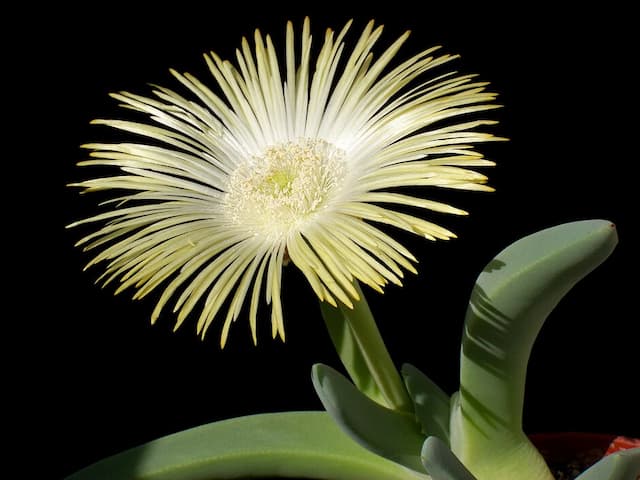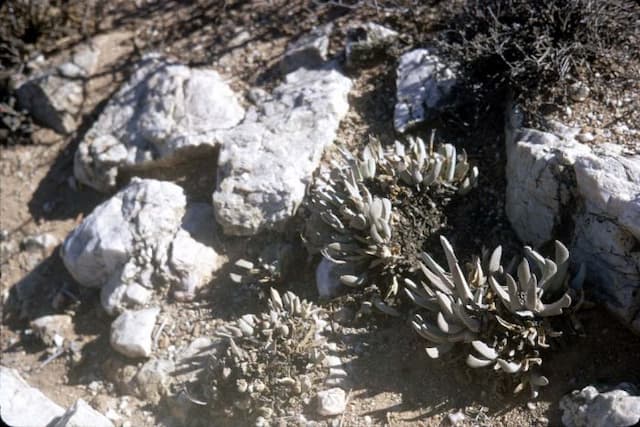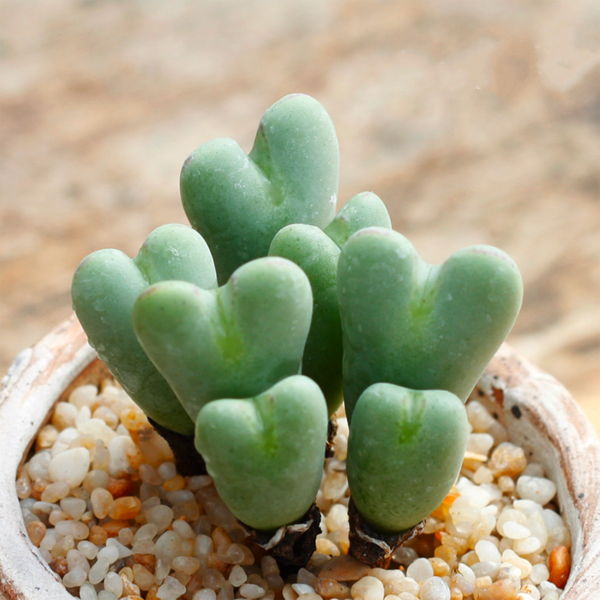Living stones Lithops localis

ABOUT
The plant, commonly known as Living Stones or Pebble Plants, bears a remarkable resemblance to stones or pebbles, blending seamlessly into its natural rocky surroundings. Its most striking feature is a pair of thick, fleshy leaves that are almost entirely fused together, with just a small slit at the top through which new leaves and daisy-like flowers emerge. The leaves come in various shades of green, brown, cream, and sometimes even pink or blue tones, often patterned with mottled spots, lines, or other intricate markings that enhance their stone-like appearance. The surface can be smooth, rough, or even slightly translucent, depending on the variety. During the flowering period, it produces vivid, cheerful blossoms that stand in contrast to its subdued, earth-toned foliage. After flowering, the plant goes through a dormancy period where the old leaves wither, and new leaf pairs form from within. Living Stones has adapted to retain moisture, allowing them to survive in arid environments. Overall, the plant offers a unique and intriguing aesthetic that makes it a favorite among succulent enthusiasts.
About this plant
 Names
NamesFamily
Aizoaceae.
Synonyms
Living Stones, Pebble Plants, Stone Plants, Split Rocks.
Common names
Lithops localis
 Toxicity
ToxicityTo humans
Lithops, commonly known as Living Stones, is not toxic to humans. There are no known toxic effects from ingesting any part of the Living Stones plant. However, as with any non-food plant, caution should still be exercised, as individual allergies or sensitivities could potentially cause gastrointestinal discomfort or other allergic reactions.
To pets
Living Stones, the common name for Lithops localis, is not known to be toxic to pets, such as cats and dogs. Therefore, ingestion of this plant typically does not lead to poisoning or serious illness. However, it is always recommended to prevent pets from eating plants as a precaution, and to watch for any signs of illness if ingestion does occur, even with non-toxic plants.
 Characteristics
CharacteristicsLife cycle
Perennials
Foliage type
Evergreen
Color of leaves
Varies
Flower color
Varies
Height
1 inch (2.5 cm)
Spread
1 inch (2.5 cm)
Plant type
Succulent
Hardiness zones
10
Native area
South Africa
Benefits
 General Benefits
General Benefits- Decorative Appeal: Lithops localis, commonly known as Living Stones, offers unique and interesting shapes and textures that mimic stones, adding an exotic and aesthetic appeal to rock gardens, terrariums, and indoor plant collections.
- Low Maintenance: Living Stones require minimal watering and care, thriving in conditions that would be challenging for many other plants, making them ideal for busy or forgetful gardeners.
- Drought Tolerance: Adapted to arid environments, Living Stones are extremely drought tolerant, storing water in their leaves and needing only infrequent watering, which conserves water.
- Education and Interest: The plant's unusual appearance and growth pattern can serve as an educational tool for plant adaptation and evolution, as well as sparking interest in botany and horticulture.
- Space Saving: Due to their small size, Living Stones are perfect for small spaces such as apartments, offices, or miniature gardens where room for plants is limited.
- Propagation Ease: Lithops localis can be easily propagated from seeds or division, which allows gardeners to expand their collection or share with others without buying new plants.
 Medical Properties
Medical PropertiesThis plant is not used for medical purposes.
 Air-purifying Qualities
Air-purifying QualitiesThis plant is not specifically known for air purifying qualities.
 Other Uses
Other Uses- Lithops localis, commonly known as living stones, can serve as an educational tool for teaching about camouflage and adaptation in plants, due to their stone-like appearance that helps them avoid predation.
- They are used in rock gardens to complement other succulents and rocks, adding unique textures and forms that replicate the look of a natural rocky landscape.
- In miniature gardens or fairy gardens, living stones are often used to create a whimsical, scaled-down desert scene.
- Living stones can be used in crafting and as a natural decor element in terrariums, due to their small size and low water requirements.
- These plants are popular among photographers and artists for their intriguing shapes and textures, making them an excellent subject for botanical art.
- Lithops localis can be used in bonsai culture, providing an interesting juxtaposition to traditional bonsai trees with their fleshy, ground-hugging form.
- They serve as an interesting conversation piece when used as a desktop or office plant because of their unique appearance that often sparks curiosity.
- As part of a sensory garden, living stones can provide a unique tactile experience with their firm, stone-like surface.
- Living stones can act as a learning project for children, teaching them about the care and growth of succulents, as well as the importance of water conservation in plants.
- They can be used in container gardening to create compact displays that can easily be moved and rearranged as design elements on patios and balconies.
Interesting Facts
 Feng Shui
Feng ShuiThe Living Stones is not used in Feng Shui practice.
 Zodiac Sign Compitability
Zodiac Sign CompitabilityThe Living Stones is not used in astrology practice.
 Plant Symbolism
Plant Symbolism- Resilience: As Lithops localis, commonly known as "living stones," can survive in arid environments and go long periods without water, they symbolize the ability to withstand harsh conditions and adversity.
- Camouflage: Their resemblance to stones offers a natural camouflage – symbolizing protection, blending in, and adaptation to surroundings.
- Patience: Living stones grow slowly, teaching patience and reminding us to value the progress of growth no matter how gradual it may be.
- Conservation: Their efficient use of water represents conservation and the importance of managing scarce resources wisely.
- Perseverance: The living stone's life cycle, enduring extreme climates and blooming despite it, is symbolic of perseverance and the ability to flourish under difficult circumstances.
 Water
WaterLiving stones, or Lithops, should be watered sparingly. During the growing season, in the spring and autumn, water them every two weeks with about an ounce of water per plant, assuming you have a small pot about 2-3 inches in diameter. During the summer, their dormant period, refrain from watering. In the winter, they need even less water; you can wait for the soil to dry out completely between waterings, roughly once a month, and then apply an ounce of water. Always ensure the pot has good drainage to prevent root rot.
 Light
LightLiving stones thrive in bright light with some direct sunlight. They are best placed in a south-facing window where they receive plenty of light for most of the day. However, in extremely hot climates or during peak summer, they should be protected from the harshest midday sun, which could scorch their fleshy leaves. A spot that receives morning sun and afternoon shade would be ideal.
 Temperature
TemperatureLiving stones prefer temperatures between 65 and 80 degrees Fahrenheit, but they can tolerate a range from 50 to 90 degrees Fahrenheit. They originate from hot climates, so they do well in warmer temperatures and should be protected from freezing temperatures. Ideally, keep them away from cold drafts and frost, which can damage the plants.
 Pruning
PruningLiving stones generally do not require pruning. The only time they might need tidying up is when the old leaf pair, from which the new leaf pair has emerged, has died and dried. This usually occurs once a year, and the dead leaves can be gently removed to prevent any potential rot that might harm the new leaves.
 Cleaning
CleaningAs needed
 Soil
SoilThe best soil mix for Living Stones is a well-draining one, such as cactus potting mix with added perlite or pumice for increased aeration. The ideal soil pH for Lithops should be around 5.5 to 6.5.
 Repotting
RepottingLiving Stones should be repotted every few years or when they outgrow their pot, typically every 3 to 4 years, being careful not to damage the roots.
 Humidity & Misting
Humidity & MistingLiving Stones thrive in dry conditions with low humidity levels; they prefer arid environments similar to their native South African habitat.
 Suitable locations
Suitable locationsIndoor
Use bright light and a gritty soil mix for indoor Living Stones.
Outdoor
Ensure full sun to partial shade in well-draining soil for outdoor Living Stones.
Hardiness zone
10-11 USDA
 Life cycle
Life cycleThe life of Lithops localis, commonly known as living stones, begins with seed germination which occurs after rainfall, and the tiny seeds need light to germinate. As they grow, these succulents develop two thick, fleshy leaves that are used for water storage, and the old leaves are absorbed by the new ones. In some years, when conditions are adequate, typically between late summer and early winter, a single, daisy-like flower emerges from between the leaves. After pollination, which is usually carried out by insects, the flowers develop into fruit capsules that open when they become wet from rain. Seeds are dispersed when more rain shakes the capsule, allowing them to fall into nearby soil. The living stones continue to live for many years, with individual plants often surviving for decades, growing slowly and blending into their rocky surroundings.
 Propogation
PropogationPropogation time
Spring to summer
The most popular method of propagation for Lithops, commonly known as living stones, is from seeds. The best time to sow Lithops seeds is in the warmer seasons, typically between spring and summer, when temperatures are around 65°F to 80°F (18°C to 27°C). To propagate by seeds, start by filling a shallow tray or pot with a fast-draining cactus mix and lightly scatter the tiny seeds over the surface. Gently press the seeds into the soil without covering them, as they need light to germinate. Water sparingly, using a fine mist to keep the soil just moist, and cover the container with a piece of glass or clear plastic to maintain humidity. Place the container in a warm, bright spot with indirect sunlight. Germination can take anywhere from a few weeks to a couple of months, and after the seedlings have grown sufficiently and the danger of scorching summer heat has subsided, they can be carefully transplanted into their own containers.


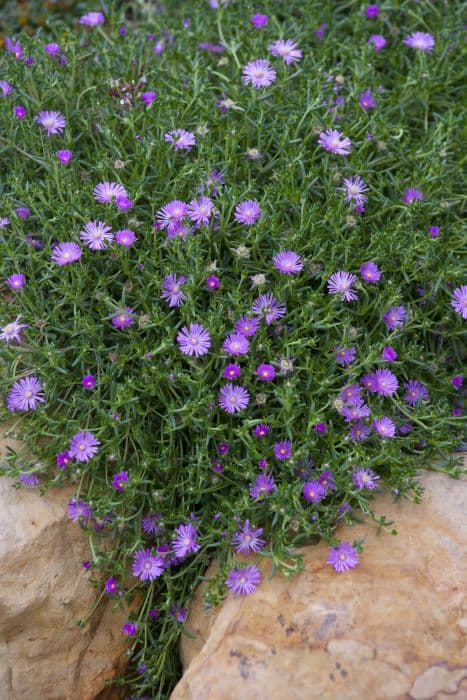
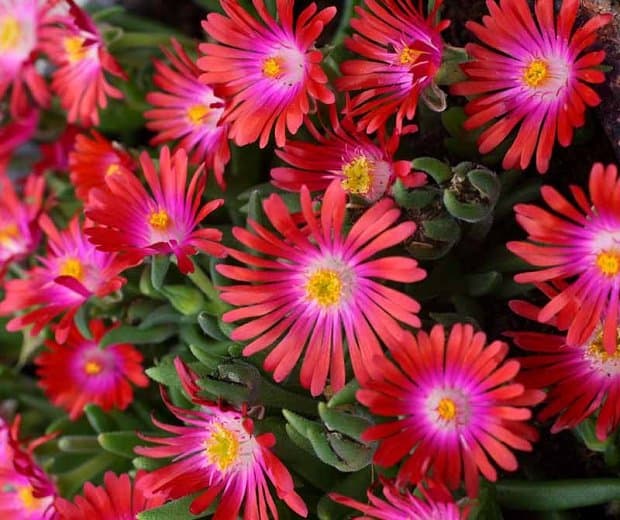
![Ice plant [Fire Spinner]](/_next/image?url=https%3A%2F%2Fplants-admin.emdemapps.com%2Fimages%2Fplants%2F%2Fimages%2F604b54d98722a.png&w=640&q=75)


